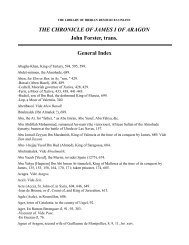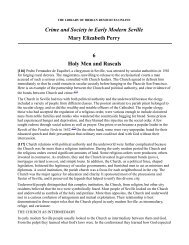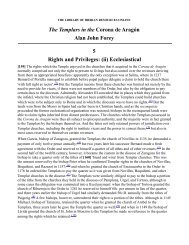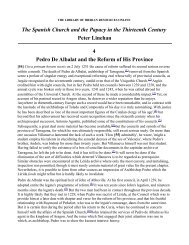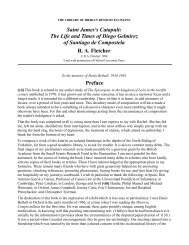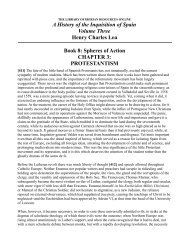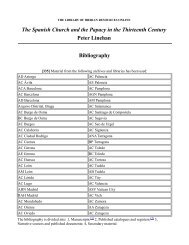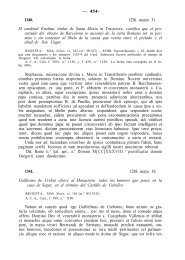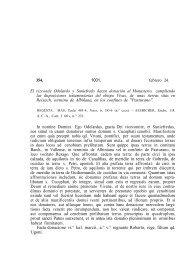Chapter 12 - The Library of Iberian Resources Online
Chapter 12 - The Library of Iberian Resources Online
Chapter 12 - The Library of Iberian Resources Online
You also want an ePaper? Increase the reach of your titles
YUMPU automatically turns print PDFs into web optimized ePapers that Google loves.
een standard in Mediterranean irrigation systems since Akkadian and Babylonian times. See Jorgen<br />
Laessoe, "<strong>The</strong> irrigation system at Ulhu, 8th century B.C.," Journal <strong>of</strong> Cuneiform Studies, 5 (1951), 25-<br />
26, on the variety and hierarchy <strong>of</strong> canal names: "Hirîtu seems to be a main canal from which smaller<br />
and narrower ditches branch <strong>of</strong>f. iku, palgu, and atappu all seem to belong in this second category". In<br />
Babylonia, the larger canals were called narû, i.e. river, cf. Arabic nahr (R. J. Forbes, Studies in<br />
Ancient Technology, II, 21). In Iraq today -- to cite but one example drawn from the Islamic world --<br />
the main canal is called jadwal; the primary and secondary feeders bada and naharân; still smaller<br />
channels 'umud; followed by the equivalent <strong>of</strong> a Valencian cequiola, the mirriyân, which runs only the<br />
length <strong>of</strong> a plot, finally there is the sharûgh, or irrigation furrow (Fernea, Shaykh and Effendi, p <strong>12</strong>2).<br />
Three thousand years <strong>of</strong> continuity in irrigations terminology indicated by Babylonian naru, Arabic<br />
nahr, naharân, and Valencian almenara, from the same root (see below, nn. 15, 54) is truly impressive.<br />
8. Caro Baroja, "Norias, azudas, aceñas," pp. 52-59.<br />
9. F. W. Maitland described the instability <strong>of</strong> agrarian terminology in Norman England whereby Anglo-<br />
Saxon, French, and Latin terms were "rudely intermixed" during the transitional period following the<br />
Conquest and finally emerged as an organic whole as some synonyms perished and others survived;<br />
Domesday Book and Beyond (London, 1897), pp. 8-9. A similar situation was produced in Valencia<br />
after the Reconquest, with the difference that no kingdomwide standardized irrigation terminology ever<br />
evolved. Frequently Latin documents included both the arabism and the Romance equivalent in such<br />
phrases as "azutum sive resclosa" or "cequia sive aqueductus." But in the majority <strong>of</strong> Valencian<br />
documents the arabism was preferred to the Romance form; see documents <strong>of</strong> <strong>12</strong>70 and 1318, where<br />
açut is declined in Latin (azutorum, azulo cequiae, azuta) -- Branchat, Tratado de derechos, III, pp 196,<br />
202. <strong>The</strong> use <strong>of</strong> arabisms to describe institutions or artifacts <strong>of</strong> long establishment in Christian Spanish<br />
culture is perplexing to Neuvonen (Arabismos, p. 307). <strong>The</strong> problem, really, is not one simply <strong>of</strong> the<br />
long existence <strong>of</strong> a given object but <strong>of</strong> the relative value ascribed to it by each culture. See Bellver and<br />
Cacho's comments on the use <strong>of</strong> "cequia" for all open water-conducting ditches beside the continued<br />
use <strong>of</strong> the Latin canalis (in the derived forms canal, canalat) but only in the restricted sense <strong>of</strong> a ro<strong>of</strong><br />
gutter (Influencia, p. 45).<br />
10. See Neuvonen, Arabismos, esp. intro, chap summaries, and concl., pp. 28-33, 81-83, 135-137, 257-<br />
260, 300-310. <strong>The</strong> percentage <strong>of</strong> agricultural (including irrigation) terms passing into Spanish in the<br />
three periods considered is constant: 13.2 percent (711 to mid-eleventh century), 9.6 percent (mideleventh<br />
to end <strong>of</strong> twelfth), and 10.1 percent (thirteenth century). Note also the lag between the<br />
generalization <strong>of</strong> a phenomenon in Al-Andalus and the diffusion <strong>of</strong> the arabism into the Romance<br />
vernaculars. Rice was grown in Spain from the eighth century on, but the use <strong>of</strong> the arabism arroz in<br />
Romance became commonly only after the great conquests, in the thirteenth century (ibid., p 164).<br />
11. On açut see Neuvonen, Arabismos, pp. 132--133; Corominas, Diccionario, I, 352; Alcover,<br />
Diccionari, II, 87. Cf. the Granadan term maglaca (control gate?) from the Arabic ghalaqa, to close,<br />
cut <strong>of</strong>f (Franquet y Bertrán, Ensayo, II, 178). Sadd is the common word for dam in modern Yemen<br />
(Rossi, "Irrigazione nel Yemen," p. 349).<br />
<strong>12</strong>. On albellon, Neuvonen, Arabismos, p. 253, the Castilian form, albollón, passed into that language<br />
through Aragonese. Also see Diaz Cassou, Huerta de Murcia, p. 226 n.1, and Ordenanzas y<br />
costumbres, p. 67, n.1. For use <strong>of</strong> this word in the context <strong>of</strong> irrigation, see ARV, Gobernación. 2214,<br />
7th hand, fol. 46v (Mar. 26, 1416): "los albellons qui de present hi son per a obs de regar les dites<br />
terres" (re. Rabana Canal, in Játiva).<br />
13. On alcaduf, Corominas, Diccionario, 1, 250-251; Neuvonen, Arabismos, 145--146; Alcover,<br />
Diccionari, I, 437; G. S Cohn, "La noria marocaine," p. 29 n. 1; Glick, "Medieval irrigation clocks," p.<br />
426.




